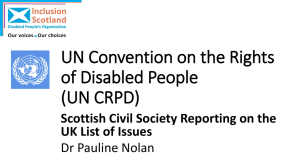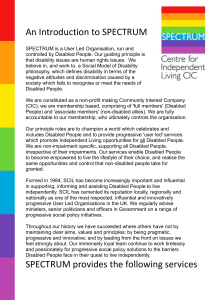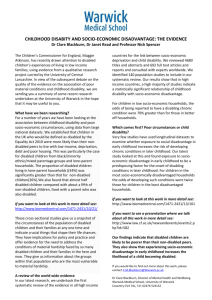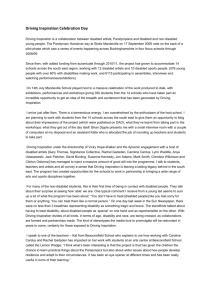A Different Perspective on Disability Equality
advertisement
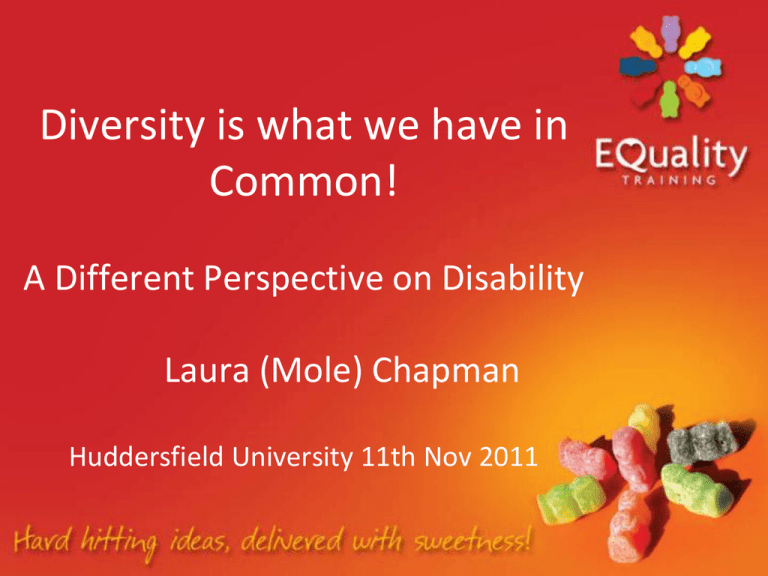
Diversity is what we have in Common! A Different Perspective on Disability Laura (Mole) Chapman Huddersfield University 11th Nov 2011 Welcome “paid pests.” These are the scholars “whose function it is to disrupt and intervene in conversations in ways that are disturbing and force people to ask why they frame the questions in the way they do or why they make the analysis they do.” (Marshall, C. et al 2006, P.21.) Culture Change • Tackling inequality is best understood as a practitioner’s ethical commitment to realise every learner’s rights in full. • Cultural change takes both time and innovation: it is neither immediately available nor instantly achievable. (Adapted from Chapman, L. 2010) Culture Change Welcome Tolerance Single /other Deficit Barriers Rigid rules Compliance Improvement Chapman, L. 2010 pg. 26 Invitation Acceptance Diverse Assets Boundaries Flexible Principles Commitment Transformation Key questions for education Inequality raises key questions about whether educators be aiming for the same for everyone or fairness for everyone. Should educators be trying to secure more equal outcomes across a narrow set of measures, or do we need a broader set of measures to reflect different ambitions and notions of success? From Kerr & West 2010 BERA pg .121 Disabilism The disadvantage or restriction of activity caused by contemporary social organisation which takes little or no account of people who have impairments and thus excludes them from the mainstream of social activities. Articulating Disablism Fred Brown (the person) is a man with cerebral palsy (the impairment). When the barriers and disablism (the oppression) that restrict Fred have been removed from society, Fred will no longer be disabled, but he will still have cerebral palsy and be called Fred. Disabling Assumptions The characteristics of disablism Outcomes Feeling Action The Facts • Visually impaired people are four times more likely to be verbally and physically abused than sighted people • People with mental health issues are 11 times more likely to be victimised • 90% of adults with a learning difficulty report being 'bullied'. Scope 2008 Compared with non-disabled people, disabled people are: • more likely to be economically inactive – only one in two disabled people of working age are currently in employment, compared with four out of five nondisabled people; • more likely to experience problems with hate crime or harassment – a quarter of all disabled people say that they have experienced hate crime or harassment, and this number rises to 47% of people with mental health conditions; "on the experience of disability, history is largely silent, and when it is discussed at all, it is within the context of the history of medical advances. Just as women and black people have discovered that they must write their own histories, so too with disabled people.” Oliver and Campbell 1996 The Medical Model of disability the personal domain • Medical approach to the problem. • Defined by non-disabled professionals • Equated to illness in terms of research and findings. • Care and benefits have been awarded to compensate for personal tragedy. The Social Model of Disability the public domain • The problem owned by the whole community. • It defines the problem in terms barriers: attitudinal, structural and systemic. • Acknowledges the oppression and a requirement for action. • It recognises disabled people’s voice in distributed or shared leadership. Appropriate Dialogue • Personal: inner, reflective, analytical, synthesizing. The way issues are internalized. A process that makes sense. [Private voice] • Social: family and friends, deep, open, direct, love and unconditional acceptance. [Personal voice] • Professional dialogue: a closed ‘expert’ language - ‘jargon’ to the outsider. The writer, the journalist and the professional communicator… the questioning of technique and practice. [Public voice] • Learning dialogue: process of mentoring, coaching, and tutoring. Enquiry, discovery, questioning, affirming. [Expert voice] • Community dialogue: process of debate and shared decision taking. Trust, convention, shared understanding and protocol. [Shared voice] West-Burnham, J. 2009, pg 122 Social Justice As stated by Prof. West-Burnham: The principle of equality has to be reinforced and extended by the practice of equity. Equality: every human being has an absolute and equal right to common dignity and parity of esteem and entitlement to access the benefits of society on equal terms. Equity: every human being has a right to benefit from the outcomes of society on the basis of fairness and according to need. Social justice: justice requires deliberate and specific intervention to secure equality and equity. (Chapman, L. and West-Burnham, J. 2010, pg.26) Inclusive practice: Inclusion is a process of identifying and breaking down barriers which can be environmental, attitudinal and institutional. This process eliminates discrimination thus providing all participants with equal access. Is an ongoing process of reviewing and developing practice in order to adjust and celebrate diversity. It is the journey not the destination! (Chapman, L. 2006, pg 4. Unpublished) Growth and Capacity building Learning and Development We must put into practice our socially just ideologies. We must move from passive discourse and involvement to conscious deliberate, and proactive practice in educational leadership that will produce socially just outcomes for all. (Marshall, C. et al, 2006, P.27) Good bye! …on Facebook or Twitter For free materials: www.equalitytraining.co.uk

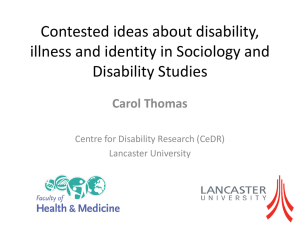


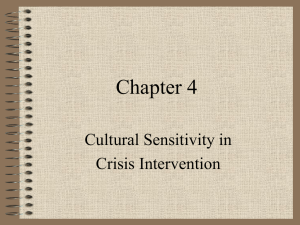

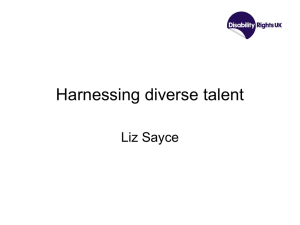
![You can the presentation here [Powerpoint, 1.01MB]](http://s2.studylib.net/store/data/005417570_1-0810139cfc2485ebcaf952e0ae8bb49a-300x300.png)
